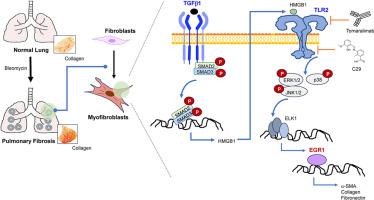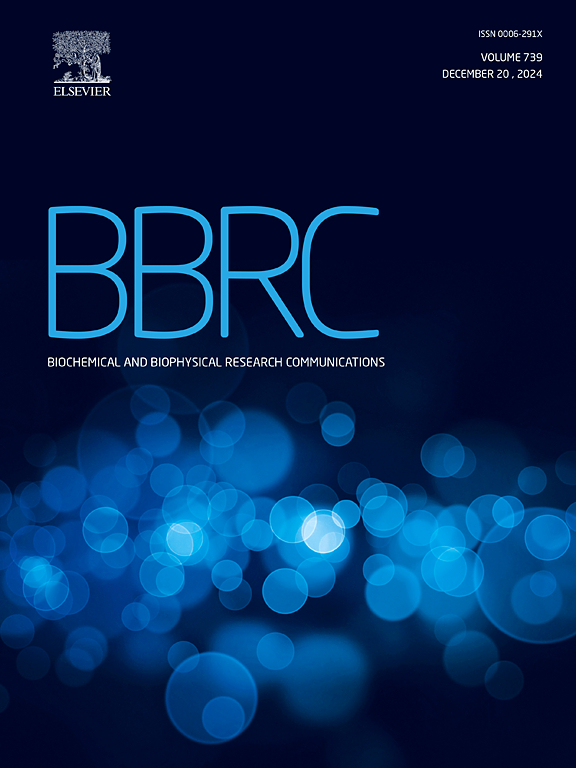TLR2–EGR1 signaling axis modulates TGFβ1-induced differentiation of fibroblasts into myofibroblasts in pulmonary fibrosis
IF 2.5
3区 生物学
Q3 BIOCHEMISTRY & MOLECULAR BIOLOGY
Biochemical and biophysical research communications
Pub Date : 2024-10-23
DOI:10.1016/j.bbrc.2024.150836
引用次数: 0
Abstract
Pulmonary fibrosis is a progressive lung condition characterized by the excessive activation of myofibroblasts. Transforming growth factor beta 1 (TGFβ1) plays a crucial role in the differentiation of fibroblasts into myofibroblasts. In addition, toll-like receptor 2 (TLR2), known for its role in immune responses, contributes to pulmonary fibrosis by promoting myofibroblast differentiation. However, the interplay between TGFβ1 and TLR2 signaling pathways in myofibroblast differentiation has remained elusive. In the present study, we investigated the involvement of TLR2 in TGFβ1-induced fibroblast differentiation into myofibroblasts using IMR-90 human pulmonary fibroblasts as a model cell line. We found that TLR2 activation induced myofibroblast differentiation by enhancing the expression of early growth response 1 (EGR1) via the mitogen-activated protein kinase (MAPK) signaling pathway. Elevated EGR1 levels were detected in the lung tissues of a bleomycin (BLM)-induced mouse model of pulmonary fibrosis. Moreover, the administration of tomaralimab, an antagonistic anti-TLR2 antibody, reduced the EGR1 expression and collagen deposition. Altogether, targeting the TLR2–EGR1 pathway could be a promising therapeutic approach for pulmonary fibrosis by blocking TGFβ1-induced myofibroblast differentiation.

TLR2-EGR1信号轴调节TGFβ1诱导的肺纤维化中成纤维细胞向肌成纤维细胞的分化。
肺纤维化是一种进行性肺部疾病,其特点是肌成纤维细胞过度活化。转化生长因子β1(TGFβ1)在成纤维细胞向肌成纤维细胞分化的过程中起着至关重要的作用。此外,因其在免疫反应中的作用而闻名的收费样受体 2(TLR2)也通过促进成纤维细胞分化而导致肺纤维化。然而,TGFβ1 和 TLR2 信号通路在肌成纤维细胞分化过程中的相互作用仍然难以捉摸。在本研究中,我们以 IMR-90 人肺成纤维细胞为模型细胞系,研究了 TLR2 参与 TGFβ1 诱导的成纤维细胞向肌成纤维细胞分化的过程。我们发现,TLR2 激活可通过丝裂原活化蛋白激酶(MAPK)信号通路增强早期生长应答 1(EGR1)的表达,从而诱导肌成纤维细胞分化。在博莱霉素(BLM)诱导的肺纤维化小鼠模型的肺组织中检测到 EGR1 水平升高。此外,服用 Tomaralimab(一种拮抗抗 TLR2 的抗体)可减少 EGR1 的表达和胶原沉积。总之,靶向TLR2-EGR1通路可以阻断TGFβ1诱导的肌成纤维细胞分化,是一种治疗肺纤维化的有前途的方法。
本文章由计算机程序翻译,如有差异,请以英文原文为准。
求助全文
约1分钟内获得全文
求助全文
来源期刊
CiteScore
6.10
自引率
0.00%
发文量
1400
审稿时长
14 days
期刊介绍:
Biochemical and Biophysical Research Communications is the premier international journal devoted to the very rapid dissemination of timely and significant experimental results in diverse fields of biological research. The development of the "Breakthroughs and Views" section brings the minireview format to the journal, and issues often contain collections of special interest manuscripts. BBRC is published weekly (52 issues/year).Research Areas now include: Biochemistry; biophysics; cell biology; developmental biology; immunology
; molecular biology; neurobiology; plant biology and proteomics

 求助内容:
求助内容: 应助结果提醒方式:
应助结果提醒方式:


